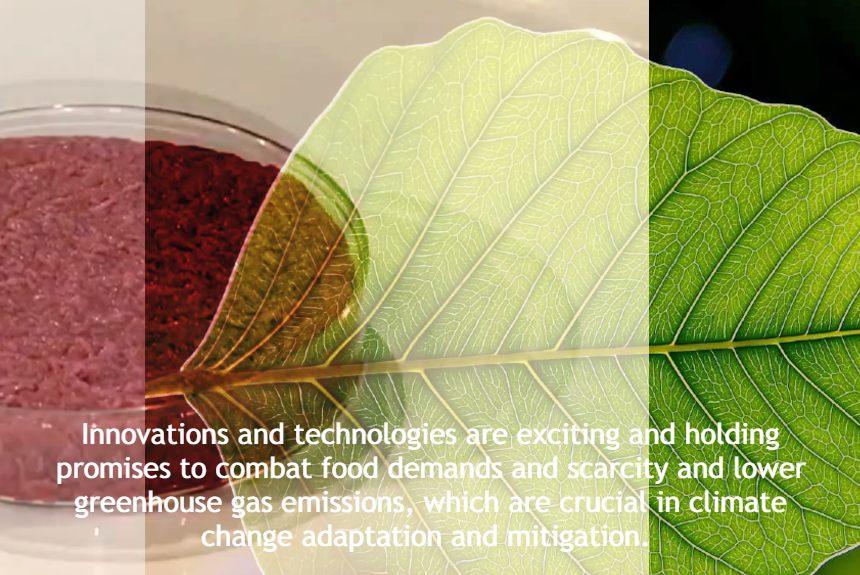According to the IPCC report, food security is at risk due to the projected decline of food production due to land degradation caused by climate change.
If this happens, would lab-grown meat and ‘tuned-up’ plants be the solution to the projected global food demands?
Proponents of lab-grown meat claim that producing cultured meat can reduce greenhouse gas emissions and significantly curb land and water use. They see it as a promising alternative to the high methane emissions from the agriculture sector as advocates are expressing firm commitments to the environment.
Lab-grown meat is made from animal stem cells that are bioengineered in the lab to multiply and grow until they form new muscle tissues. The article says it promises to replicate the natural taste and texture of meat.
Meanwhile, Bill Gates is investing in research that can double crop yield by ‘tuning’ up photosynthesis in the plant. He says this is a solution to the growing demand for food by 2050 and to combat the stresses of climate change on food production, which faces weather challenges such as severe droughts, irregular rainfall, and the spread of pests and crop diseases (Tuning up Photosynthesis, 2019).
Lab-grown meat’s implications
Agriculture accounts for 44 % of methane emissions, so meat grown in the laboratory will help raise fewer animals and reduce methane emissions. This can appeal to people concerned about agriculture’s contribution to climate change (CNN, 2016).
However, not everyone is convinced about lab-grown meat’s environmental and health implications. For instance, Marco Springmann, a senior environmental researcher from the University of Oxford, says that meat grown in the lab has “5 times the carbon footprint of chicken, and ten times higher than plant-based meat” (CNBC, 2019).
Analysts project that the lab-grown meat industry will become a multi-billion-dollar business by 2030, and start-up labs are springing up worldwide. According to a CNBC article, the United States currently has nine cell-culturing companies and plans to release its products by the end of 2019.
Will cultured meat lower greenhouse gas emissions?
According to a CNBC report, proponents of cultured meats say that it has 96% lower greenhouse gas emissions, while others say they use less land and water.
Because lab-grown meat is still in its early stages, the actual carbon footprint of a large-scale process is challenging to assess. But claiming as an alternative to the methane-belching agriculture industry, meat laboratories will be pressed to use cleaner energy and technologies.
Suppose large-scale production of lab meat produces a lot of carbon dioxide. In that case, it will be more damaging than the methane emissions from raising animals, as carbon dioxide persists for hundreds of years in the atmosphere compared to methane, which lasts only 12 years.
Researchers believe tuned-up plants will double their productivity
Bill Gates’ research claims that tuning up photosynthesis in the plant can double its productivity (Tuning up photosynthesis, 2019).
We first learned about photosynthesis in school. It is a chemical reaction that takes place inside a plant, producing food for the plant to survive. Carbon dioxide, water, and light are all needed for photosynthesis. (BBC Bitesize, 2019).
According to the research program called RIPE, an acronym for Realizing Increased Photosynthetic Efficiency, led by the University of Illinois, plants are not too efficient when it comes to using the sun’s energy as it only uses a fraction of the sunlight that fuels its growth meaning that crops are producing less than it’s potential, the article says (Tuning up photosynthesis, 2019).
Researchers can pinpoint the changes that need to be done between the 170-step chemical process of photosynthesis, particularly how plants can speed up turning sunlight into energy to produce more crops in rice, cassava, soybeans, cowpea, and others, the article says.
Tuning up photosynthesis can solve the growing demand for food, especially since the most significant demand would come from the poorest people living in high-population areas who rely on farming to feed their families and earn a living (Tuning up Photosynthesis, 2019).
Another thing that researchers are doing, according to the article, is fixing the enzyme Rubisco, which ‘captures carbon dioxide and turns it into sugars for the plant.’ Speeding up Rubisco will also yield higher productivity.
Afterthoughts
As these developments are still in their early stages, we cannot know how these innovations, mainly the ‘tuning up’ of plants and bioengineered meats, will impact our health, soil, ecosystems, and other animals.
Innovations and technologies are exciting and promise to combat food demands and scarcity and lower greenhouse gas emissions, which are crucial in climate change adaptation and mitigation.
Sources:
Andrew, S. (2019, October 21). Harvard researchers grew meat in a lab from cow and rabbit cells. CNN news. Retrieved from https://edition.cnn.com/2019/10/21/us/harvard-lab-grown-meat-trnd/index.html
Gates, B. (2019, October 15). Tuning up photosynthesis to feed the world. Gates Notes. Retrieved from https://www.gatesnotes.com/Development/Tuning-up-photosynthesis-to-feed-the-world?
Newburger, E. (2019, October 19). As the lab-grown meat industry grows, scientists debate. CNBC article. Retrieved from https://www.cnbc.com/2019/10/19/lab-grown-meat-could-exacerbate-climate-change-scientists-say.html
What is photosynthesis (2019). BBC Bitesize. Retrieved from https://www.bbc.co.uk/bitesize/topics/zvrrd2p/articles/zn4sv9q
PHOTO CREDIT:
First Cultured Hamburger by World Economic Forum – File: The Meat Revolution Mark Post.webm (7:48), CC BY 3.0, Link
Leaf by Jon Sullivan – PdPhoto, Public Domain, https://commons.wikimedia.org/w/index.php?curid=18858



Leave a Reply